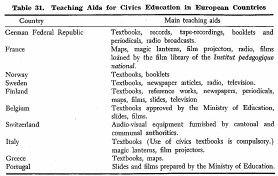| Home > Policy > White Paper, Notice, Announcement > White Paper > EDUCATIONAL STANDARDS IN JAPAN 1965 > CHAPTER |
||
In most foreign countries, religion makes a valuable contribution to the moral spirit. In those countries studied, moral education is generally given to pupils through religious instruction in assigned religion classes. In several countries including the U.S.A. and France, religious instruction in public schools is prohibited. Whether the religious instruction in public school is conducted or not, moral and ethical education is given in many cases as a part of other subject, usually 'civics'.
In communist countries including the U.S.S.R., it is regarded as a purpose of education to build a citizen who can contribute to the maintenance of a socialist state. For this purpose, moral and ethical trainings given through all educational activities in the schools.
Table 30 shows the extent of ofFerings in religious education in ele-mentary and secondary schools in the U.S.A., the U.K., and an extensivegroup of European countries.
In 13 of the 17 countries listed in Table 30, religion is offered as a separate subject in almost all grades in public elementary and secondary schools. In 11 of the 17 countries, 'civics' is taught in elementary school or secondary school or both. In France, civics at primary level is included in the subject known as 'education civique et morale'. In the U.S.A. 'civics' is usually taught in the 8th grade and upper grades of secondary schools. There is no instruction in separate moral education classes. It is taught through all subjects. Also, in the U.S.S.R., moral education is not treated separately, but moral training of pupils is given through the whole curriculum. It is a characteristic feature of school education in the U.S.S.R. to provide child labor training at all levels. This labor training aims to give pupils moral training. Moreover, 'Rules for Pupils', which pupils elementary and secondary schools must obey, are specified by the Department of Education of the R.S.F.S.R. In 'Rules for Pupils', objectives of moral education are prescribed along with the school principles which pupils must observe.
Civics teaching in each country aims to elevate moral sentiments, and to give pupils knowledge and understanding of government, economics and social problems necessary for citizenship.
Moral education and civics in the Federal Republic of Germany, Italy, France and Belgium are as follows:
Federal Republic of Germany
Basic principles of civic education in schools and universities were decided by the Conference of Lander Ministers of Education of 15 June 1950as follows:
"Civic education should awaken in pupils both a moral response and a determination to act as a responsible member of society."
Italy
The primary school syllabus published by the Ministry of Education in 1955 states that civics teaching is designed to "give the child a general moral, religious and social training." It also emphasizes that "religious instruction must enable the child to acquire basic habits of morality, civic and social behavior and hygiene at home, at school and in society; and to give the child a sense of personal responsibility and membership of a group." Regarding civic education courses in upper classes it is stated: "love of one's country must be a natural extension of love of one's family, and the awareness of national values should be related to the ideal of international understanding."
France
The syllabus in primary education published by the Ministry of Education in 1923 states that "moral education must enable the child to grow up as a man with a balanced development of sentiment, intelligence, and conscience." It is also stated that "moral instruction is to be designed not only to give the child moral spirit, but also to lead him to realize this spirit in daily life."
In primary schools in France, the subject known as education civique et morale is taught as outlined below:
1st grade:
Listening to stories (Fontaine's fables, Hans Christian Anderson's tales, etc.) and to biographies of great men told by teachers.
2nd and 3rd grades:
To accustom the child to acquire good habits through reading of book-lets followed by discussion, and discussion on school events. At third grade the same themes as those of second grade are dealt with more intensively
4th and 5th grades:
To listen to narratives or discuss deeds of the individuta1 and social morality concerned with moderation, sincerity, simplicity, kindness, courage, and generosity.
To give the child an understanding of the value of labor, a spirit of cooperation with others, observance of promises, understanding of other persons and appreciation of duties to one's family and one's nation.
At fifth grade, the same themes as those of forth grade are dealt with more intensively.
6th--8th grades:
To provide the child consciousness and respect for man, character formation, main duties' in life of the individual, at home and in society, and inculcate patriotism, justice and mutual assistance, respect for labor, organization of government and its activities, elementary knowledge of contracts and labor laws in daily life, elementary knowledge of the legislative, administrative and judicial systems, citizen's rights and duties and international understanding.
Belgium
In the middle school of Belgium (3rd and 4th secondary years, age 14 to15), "citizenship and patriotism" are taught under the following themes:
l) Citizen's rights: advantages of the democratic and parliamentary system. The chief freedoms guaranteed by the Belgian Constitution.
2) The citizen's duties: the ballot; obedience to the Law, military service; paying taxes; giving evidence in court.
3) Patriotism: the country's prestige and its heritage; the dangers of misguided patriotism.
4) International understanding and a sense of the brotherhood of man. Aids for Civics Teaching in European Countries
In a number of countries, separate textbooks are used. Audio-visual aids such as slides, films, radio broadcasts, television, etc. are also used.


| Back to Top | MEXT HOME |